 |
| FTLComm - Tisdale - June 19, 2000 |
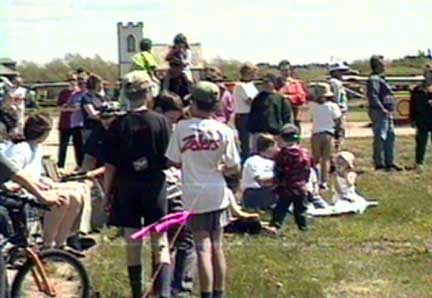 Tisdale's
mechanised weekend has to be rated as a roaring success. The motorcycle rally Saturday
morning, the race track in operation Saturday
and Sunday and Sunday morning the spectacular aviation show. Tisdale's
mechanised weekend has to be rated as a roaring success. The motorcycle rally Saturday
morning, the race track in operation Saturday
and Sunday and Sunday morning the spectacular aviation show. The morning air show involved a fly-in of ultra-light, home built and vintage aircraft with flying demonstrations. But the highlight of the show for most of the large crowd on hand to enjoy the event was the fly past and fire redardant drop by two water bombers. The Grumman Tracker were once the standard antisubmarine patrol aircraft for Canadian and American aircraft carriers in the 1950s. Built to handle the punishment of carrier landings these machines are among the most reliable and |
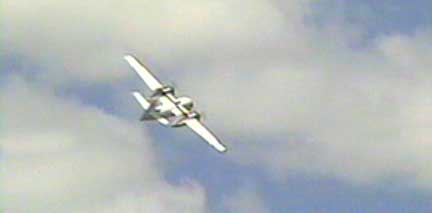 tough aircraft
ever built. When tough aircraft
ever built. Whenthey were retired from active military service these Pratt and Whitney powered work horses were transformed by Con-Air in Abbottsford into "FireCat" water bombers for forest fire surpression. Operating from a tanker base using fertilizer enhanced fire retardant these machines can be extremely effective against a fire line, especially if they can get at the fire before it becomes a massive conflagration. To guide the bombers to target each group of water bombers rely upon a light |
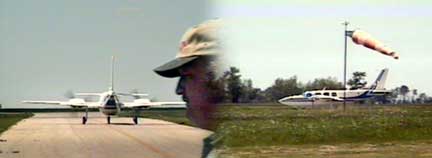 twin aircraft
to act as a bird-dog twin aircraft
to act as a bird-dogwith a pilot and fire boss on board. Saskatchewan's fire service uses Beechcraft Barons for this task and the A-26 Units from Alberta's Airspray use Cessna 310s but this unit and Conair's DC6s utilise the rather unusual Ted Smith Aerostar seen here on the right. This mid-wing executive piston powered speed demon that can cruise at between 253 and 300 mph was made from 1969 until 1981 when Piper who had purchased the company ended production. Capable of carry six passengers well over a thousand miles. But in its fire fighting role the Aerostar uses its speed to keep ahead of the water bombers designating the strike targets. |
 |
| Richard VanGrunsven design his all metal single seat home built (above) and it was an award winner for best aerodynamic detailing in the EAA (Experimental Aircraft Association) competition in 1972. This superb example was on display Sunday. This outstanding designed aircraft has a single "I" beam and a lighter rear spar for its wings, the fuselage and tail are built of light alloy with a fiberglass cowling, fixed conventional tail dragger undercarriage with fiberglass fairings. The performance for this aircraft is amazing. Weighing only 695 pound empty it can take off with a gross weight of 1050 pounds. It can carry 24 US gallons of fuel and has a top speed of 195 mph cruising at 185 and stalling at 48. It will get off the ground in 200 feet and has a service ceiling of 21,000. Its 19 feet eleven inch wings and nineteen foot body will carry its pilot for 600 miles. |
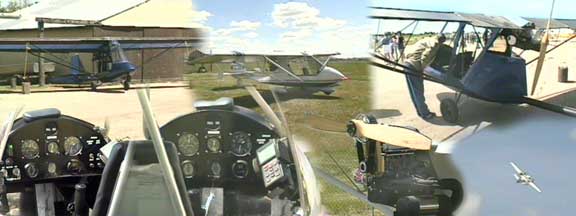 |
| Two outstanding ultra light aircraft were part of the fly-in the blue Beaver and the white Challenger. These amazing aircraft are great for photography and observing wild life but are severely limited with wind and weather conditions. |
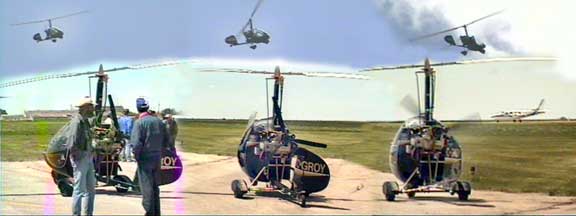 |
| The gyro copter seen above was built in Kindersley before the company went out of business. Based on the concept of a spinning, non-powered wing gyro copters were popular in the 1930s but because of the inexpensive developments with monoplanes they became a novelty. In the 1960 a fellow called Benson revived the idea with a less sophisticated version of this style of aircraft. The Benson machines were homebuilts and had some popularity. One really impressive gyro copter named "little Nel" became famous when used in a Roger Moore James Bond movie and seriously injured its pilot during the filming of the project. The demonstration flight with this one was excellent as the pilot taxied out on the runway and was airborne in less then one hundred feet then came down and landed without and roll whatever. The aerial movement was almost insect like as the craft can change directions quickly and precisely. |
 |
| These three home builts were on displace, each of the utility back country type and all three are two place machines with rotax (snow machine) engines. |
 |
| There were a lot of really excellent vintage aircraft on hand as three are shown above, an Ercoupe/Aircoupe, a Taylorcraft and a Cessna 140. The Taylorcraft was the pre-Piper cub as the design sold out to Piper who built a whole line of aircraft built on this excellent flying steel tube fabric covered machine. The Cessna 140 was of course the small version of the most popular aircraft of all time, the 172. |
 Truly an wonderful event with families and flying enthusiasts out to see and experience the world of flight. Helicopter rides were a part of the programme as people lined up for a ride in a Bell Jetranger while others found some shade and had a family picnic. Congratulations to the organisers of this marvellous event. |